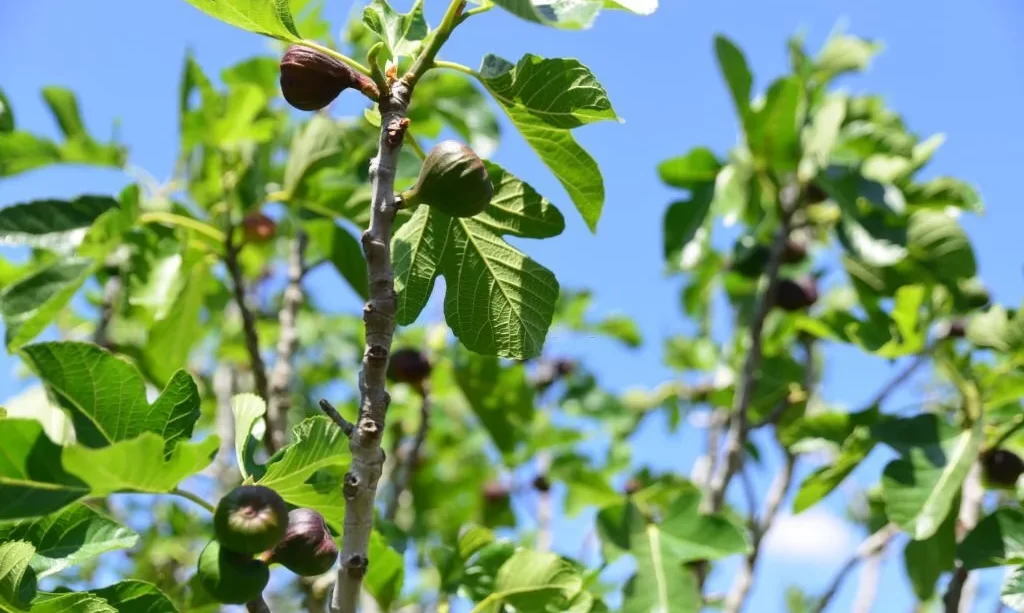Fig trees are prized for their sweet, succulent fruits and lush, green foliage, making them a cherished addition to many gardens. To ensure the vitality and productivity of these remarkable trees, it’s crucial to understand and meet their water needs. This guide explores the essential factors that influence how much water a fig tree requires and offers insights into proper watering practices.
- Down to Earth Fruit Tree is a five pound box of all natural fertilizer with 6-2-4 formula and is listed by the Organic Materials Review Institute (OMRI) for use in organic production
- Specially formulated to encourage productive home orchards full of the delicious and nutritious tree fruits now popular in many backyard gardens
- Fruit Tree fertilizer provides primary nutrients for plant growth plus added calcium for proper fruit development, so you can enjoy bountiful crops of home grown fruit
- From apples, pears and plums to mangos, pomegranates and figs, Fruit Tree can be used on all varieties of fruiting canes, shrubs and trees
- Ingredients: Feather Meal, Fish Bone Meal, Calcium Carbonate, Langbeinite, Potassium Sulfate, Alfalfa Meal and Kelp Meal
Fig Tree Water Needs
To effectively meet the water requirements of your fig tree, it’s essential to comprehend why water is vital and what influences its consumption. In this section, we delve into the fundamental aspects of fig tree water needs:
- Water for Growth: Like all plants, fig trees need water for photosynthesis, the process by which they convert sunlight into energy. Water is also essential for nutrient uptake from the soil and cellular processes within the tree.
- Transpiration and Evaporation: Fig trees lose water through transpiration, a process where water is drawn up from the roots and released through tiny openings (stomata) in their leaves. Additionally, water evaporates from the soil surface surrounding the tree. These processes collectively contribute to the tree’s water needs.
- Soil Moisture: The moisture content of the soil directly impacts a fig tree’s access to water. Soil acts as the reservoir from which the tree draws moisture. The ability of the soil to retain water and provide it to the roots is a key factor in sustaining healthy fig trees.
By understanding the role of water in fig tree growth and recognizing the interplay of factors like climate, soil type, and tree age, you can effectively determine how much water your fig tree requires for optimal health and fruit production.
Factors Affecting Water Requirements
Fig tree water needs can vary based on several factors. Understanding these variables is essential for providing the right amount of water to your tree. Here are the key factors affecting fig tree water requirements:
- Climate: The local climate, including temperature, humidity, and rainfall patterns, plays a significant role in determining how much water a fig tree needs. Hotter and drier climates generally require more frequent watering, while cooler and more humid regions may need less.
- Soil Type: The type and texture of the soil in which your fig tree is planted influence its water retention capacity. Sandy soils drain quickly and may necessitate more frequent watering, while clay soils retain moisture for longer periods.
- Drainage: Proper drainage is crucial for fig trees. Waterlogged soil can lead to root rot and other issues. Ensure that the planting area has good drainage to prevent water from pooling around the roots.
- Tree Age and Size: Young fig trees typically require more water to establish their root systems. As they grow and mature, their water needs may decrease. Consider the age and size of your fig tree when determining watering frequency.
- Growth Stage: Fig trees go through different growth stages, including dormancy, vegetative growth, flowering, and fruiting. Water requirements can vary during these stages, with increased demands during flowering and fruiting.
- NUTRIENT RICH & INDOOR/OUTDOOR FAST GERMINATION… Wonder Soil Premium Organic Potting Soil Mix is the only dry compressed coco coir mix with added amendments of worm castings, mycorrhizae, kelp, perlite and more! Grow your plants faster with stronger roots! Peat free, all natural, family and pet safe!
- A LITTLE DOES A LOT… your little BIG bag of compressed indoor potting soil & garden soil for outdoor plants expands to 4 TIMES THE SIZE when mixed with water; easy to carry & saves vital shed space.
- PRE-MIXED & READY TO USE ORGANIC POTTING MIX … Pre-mixed and ready to use organic potting soil and garden soil mix to help make your gardening or hobby growing a breeze. Simply transplant your desired plants into their new container and add our soil mix or pour our soil mix and plant your seeds.
- WATER RETENTION & DRAINAGE… Coco coir has excellent water retention with dependable drainage and aeration in the root zone. Save up to 50% of water, fertilizer, and seed!
- HEAVY DUTY RESEALABLE BAG… Use what you need and save the rest for later! Keeping your planting soil dry and safe!
Determining When to Water
Knowing when to water your fig tree is essential for preventing both overwatering and underwatering. Here are some practical guidelines for determining the right time to water your tree:
- Soil Moisture Test: Use a simple soil moisture test by inserting your finger or a moisture meter into the soil near the tree’s root zone. If the soil feels dry to a depth of about 2-3 inches (5-7.5 cm), it’s time to water. Avoid watering when the soil is still moist.
- Visual Cues: Observe your fig tree for visual cues. Wilting leaves or drooping branches can be signs of water stress and indicate that it’s time to water. However, it’s essential not to rely solely on visual cues, as wilting can also be a sign of overwatering.
- Seasonal Considerations: Recognize that fig tree water needs can change with the seasons. During the active growing season in spring and summer, fig trees typically require more water. In contrast, they need less water during the dormant winter months.
- Deep Watering: When you do water, ensure you provide enough moisture to reach the entire root system. Deep watering encourages deep root growth and helps the tree access water from lower soil layers.
- Morning Watering: Water your fig tree in the morning when temperatures are cooler. This allows the tree to absorb moisture before the heat of the day increases evaporation.
By understanding the factors influencing your fig tree’s water requirements and employing these strategies for determining when to water, you can strike the right balance and help your fig tree thrive in its specific environment.
Watering Techniques
Proper watering techniques are essential to meet the specific needs of your fig tree. Here are some effective watering methods to ensure your tree receives the right amount of moisture:
- Surface Watering: Gently apply water to the soil surface around the base of the fig tree. Use a garden hose or watering can with a gentle flow to prevent soil erosion and runoff. Avoid watering the foliage to reduce the risk of disease.
- Drip Irrigation: Drip irrigation systems deliver water directly to the root zone of your fig tree, minimizing water wastage and ensuring efficient moisture delivery. Consider installing a drip irrigation system for consistent and controlled watering.
- Soaker Hoses: Soaker hoses are porous hoses that release water slowly along their length. Place them around the base of the fig tree, and they will evenly distribute moisture to the root zone. Soaker hoses are an efficient way to conserve water.
- Basin Watering: Create a shallow basin or watering well around the tree’s base. This basin helps contain water, allowing it to penetrate deeply into the soil. Basin watering is especially useful for young fig trees.
- Mulching: Apply a layer of organic mulch, such as wood chips or straw, around the base of the fig tree. Mulch helps conserve soil moisture, reduce evaporation, and maintain more consistent soil temperature.
- Watering Bag or Spikes: Watering bags and spikes can be attached to the tree trunk to deliver a slow, consistent supply of water directly to the root zone. These devices are convenient for busy gardeners.
- Be a Gardening Master with the help of our superior and complete Drip Irrigation Kit: 10 Drip Irrigation Emitters Vortex + 20 Drip Emitters Spray + 50ft flexible & durable 5/16 irrigation tubing + 50ft 1/4 inch Drip Irrigation Tubing + 12 tubing coupler + 5 ¼ Tubing Tee Splitter + Tubing End Plugs + Water Connector + 1 x Complete Instructions Guide Hard Copy + 2 Grow your Own Vegetables & Fruits Guide full with pieces of advice and practical tips Digital Format.
- Make your own garden irrigation system kit easier than ever: run a 3/4 connection from your water source to the watering area. Use the 5/16 irrigation tubing as the mainline. Branch off with the 1/4 drip irrigation tubing and connect a maximum of 30 drip irrigation emitters. Stick the dripper stake into the soil, adjust the desired irrigation spray, and feed your plants with your own drip irrigation system. Designed to work with between 20 – 45 PSI and a maximum output of 60 gallons/hour/emitter
- Enjoy taking care of your garden with high quality adjustable spray emitters and forget about broken irrigation sprayer stakes and clogged drip heads. With a length of 6.49 inch and a sharp bottom, the irrigation bubbler stake can be easily fixed into the ground and stays still even in loose soil. Perfect for long time application, the drip irrigation emitter heads are detachable and easy to clean so you don’t worry about clogging. Make gardening less of a chore!
- Spend less, get more – UV resistant and designed for underground or above-ground installation, the Carpathen 1/4 inch drip irrigation tubing will last year-round in any weather. Use the 4 ways/2 ways/1 way couplers to create the perfect branch for your plants. Season after season the distribution tubing part of the irrigation drip system will keep your plants hydrated with minimal waste from evaporation. Choose to cut down your water bills!
- Save Your Time with Carpathn Garden Irrigation System. Our automatic drip watering system minimizes water loss by directly hydrating the roots of your plants. Easily adjust the drip emitters by rotating the cap for precise hydration. Designed for up to 3 raised garden beds, this irrigation system for the garden is ideal as a garden starter kit for healthy vegetables, an automatic watering system for potted plants, a raised garden bed watering system, or a reliable garden grid watering system
Watering Fig Trees in Different Seasons
Fig tree water requirements can vary significantly depending on the season. Here’s how to adjust your watering practices to meet the tree’s needs during different times of the year:
- Spring and Summer: During the active growing season, which typically spans from late spring through summer, fig trees require more frequent and consistent watering. Keep the soil consistently moist but not waterlogged. Water deeply to encourage root growth.
- Fall: As the weather cools in the fall, reduce the frequency of watering. Fig trees naturally slow down their growth during this season, so they require less moisture. Adjust your watering schedule to maintain slightly drier soil.
- Winter: In the dormant winter months, fig trees need minimal watering. Only water when the soil has dried out significantly. Be cautious not to overwater during this time, as excess moisture can lead to root issues in cold temperatures.
- Fruit Development: When figs are forming and ripening, typically in late summer and early fall, consistent moisture is crucial. Ensure the tree receives adequate water to support fruit development and prevent fruit drop due to stress.
- Rainfall Considerations: Be mindful of natural rainfall in your region. If your area receives regular rainfall, adjust your watering schedule accordingly to avoid overwatering. Conversely, if there’s a dry spell, be prepared to supplement with additional watering.
Adapting your watering techniques and frequency to match the changing seasons and growth stages of your fig tree helps maintain its health and encourages robust fruit production. Consistent and appropriate watering practices contribute to the overall success of your fig tree in your garden.
Signs of Overwatering and Underwatering
Recognizing the signs of overwatering and underwatering in your fig tree is essential to provide the right amount of moisture. Here are common indicators for each condition:
Signs of Overwatering:
- Wilting leaves despite moist soil, as the roots cannot absorb excess water.
- Yellowing leaves or leaf drop due to root suffocation and reduced oxygen availability.
- The development of mold or mildew on the soil surface.
- Foul or musty odor coming from the soil, indicating root rot.
- Slower growth and reduced fruit production due to stressed roots.
Signs of Underwatering:
- Wilting leaves that appear dry and crispy.
- Yellowing or browning of leaves and leaf edges due to dehydration.
- Leaf drop, especially during hot and dry periods.
- Stunted growth, smaller fruit, or premature fruit drop.
- Soil that feels extremely dry, hard, and cracked.
Proper Fig Tree Care
Maintaining the overall health of your fig tree goes beyond proper watering. Here are some additional care practices to ensure your tree thrives:
- Pruning: Regular pruning helps manage the size and shape of your fig tree, improves air circulation, and encourages new growth. Prune during the dormant winter months.
- Fertilization: Apply a balanced, slow-release fertilizer in spring to provide essential nutrients. Avoid excessive nitrogen, which can lead to excessive foliage growth at the expense of fruit production.
- Mulching: Keep a layer of organic mulch around the tree to conserve moisture, suppress weeds, and regulate soil temperature.
- Pest and Disease Control: Monitor your fig tree for pests like aphids, scale, or nematodes, and diseases like leaf spot or root rot. Address any issues promptly with appropriate treatments.
- Winter Protection: In colder climates, consider protecting your fig tree during the winter months with insulation or wrapping to prevent frost damage.
- Harvesting: Harvest ripe figs promptly to encourage continued fruit production. Figs are typically ready for harvest when they are soft, have a slightly wrinkled skin, and release easily from the tree.
- Recycled Heavy Duty Rubber tree ring works great as tree weed barrier
- Mower safe tree mulch mat does not get caught in mower like lightweight coco rings
- No landscape staples needed makes this the easiest landscaping tree ring to install
- Textured / natural color make this tree mulch pad blend in with all natural surroundings
- Porous design requires less watering and provides equal seepage to tree roots
Conclusion
Caring for a fig tree and meeting its water needs is a rewarding journey that yields sweet, delectable fruit and lush foliage. By understanding the signs of overwatering and underwatering, practicing proper watering techniques, and adjusting your care routines based on the seasons, you can nurture a healthy and productive fig tree in your garden.
Remember that fig trees are resilient and can adapt to different conditions. Regular monitoring and attentive care will help you strike the right balance in providing just the right amount of water and care for your fig tree’s unique needs. With dedication and knowledge, your fig tree can become a long-lasting and fruitful addition to your garden.








